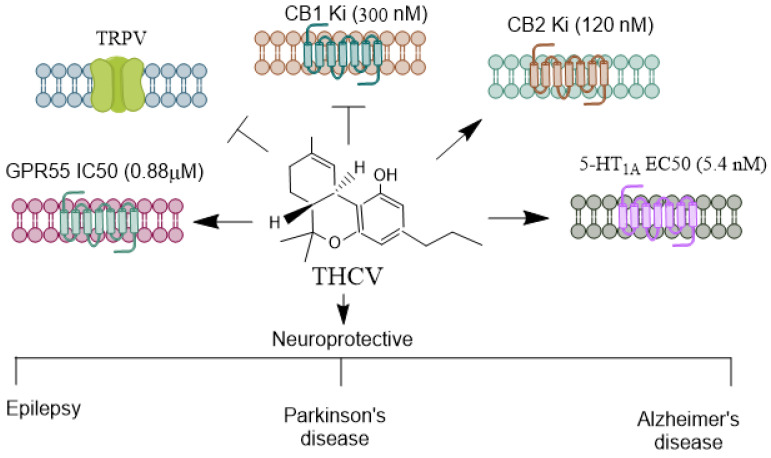Figure 3.
Receptors mediating THCV’s agonistic and antagonistic actions. THCV is a minor cannabinoid with a distinctive pharmacological profile, exhibiting both agonistic and antagonistic effects on cannabinoid and non-cannabinoid receptors. THCV has a unique interaction with CB1 receptors [21,71]. At low doses, it acts as a CB1 antagonist, which can counteract the psychoactive effects of THC. However, at higher doses, THCV can act as a CB1 agonist, producing effects similar to THC, such as appetite suppression and potential psychoactivity. THCV is generally regarded as a partial agonist of CB2, which may contribute to its anti-inflammatory and immunomodulatory properties [21,71]. THCV also modulates transient receptor potential (TRP) channels, particularly TRPV1 [72]. These channels play roles in pain perception, thermoregulation, and inflammation, suggesting THCV’s potential in managing pain and inflammatory conditions. Similar to CBD, THCV has been shown to interact with the 5-HT1A receptor [73], which is involved in spatial learning and memory, anxiety regulation, and mood modulation [74,75]. This receptor interaction may underlie some of THCV’s potential anxiolytic and antipsychotic effects. THCV activates GPR55 [76] anxiety-related behaviors [46], learning, and memory [47]. THCV’s receptor specificity and its ability to shift between agonist and antagonist roles provide it diverse therapeutic potential, particularly in areas like metabolic disorders and neuroprotection. THCV, Δ9-Tetrahydrocannabivarin; CBD, Cannabidiol; THC, Δ9-tetrahydrocannabinol; TRPV, Transient receptor potential vanilloid. →, agonist;  , antagonist.
, antagonist.

